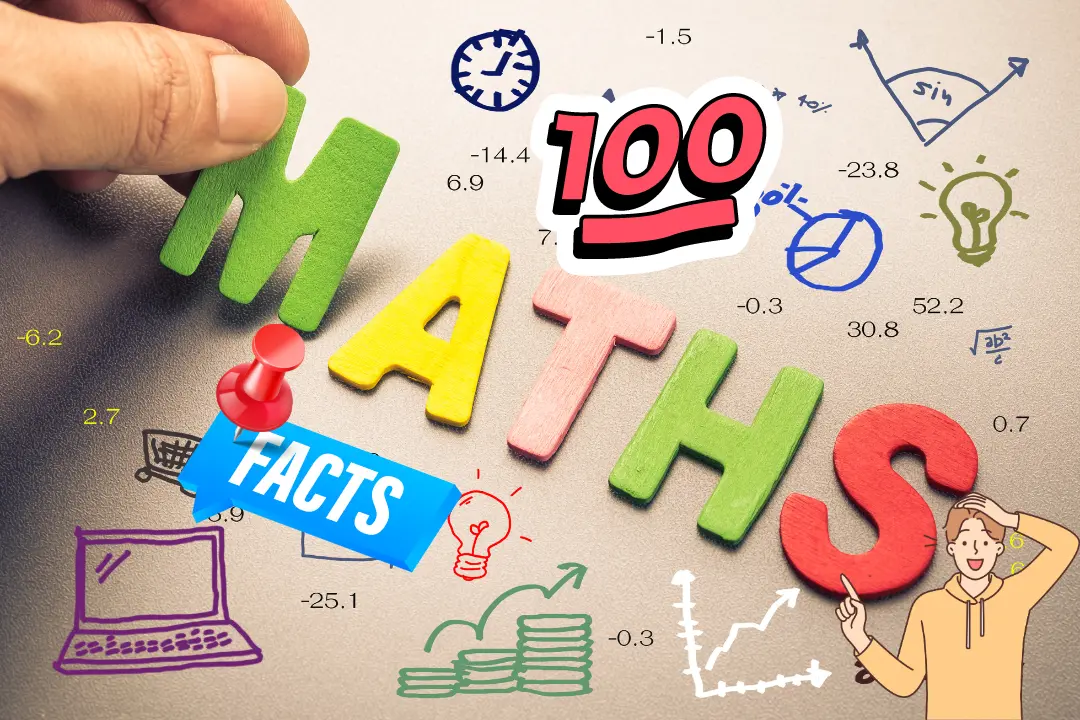100 Math Fun Facts
Hi, I'm Swarnali Saha, the founder of Welcome2Maths and a passionate math coach. I'm always excited to share the incredible world of mathematics with others. Math isn't just about numbers and formulas—it's a powerful language that explains everything from the tiniest particles to the vastness of space.
In this blog, I've compiled 100 fascinating math facts that I believe will open your eyes to the beauty, mystery, and real-life applications of math. Whether you're a seasoned math enthusiast or just starting your journey, I hope these facts spark your curiosity and deepen your appreciation for this amazing subject.
Let’s dive in and explore the wonders of math together!

Number Facts
- Zero is not Positive or Negative: Zero is the only number that is neither positive nor negative.
- Infinity is Not a Number: Infinity (∞) is a concept, not a specific number.
- Prime Numbers: Prime numbers have only two factors: 1 and themselves.
- Perfect Numbers: A perfect number is equal to the sum of its proper divisors (e.g., 6 = 1 + 2 + 3).
- Pi (π): Pi is the ratio of a circle's circumference to its diameter and is approximately 3.14159.
- Golden Ratio: The golden ratio (φ) is approximately 1.618 and is found in various natural patterns.
- Fibonacci Sequence: Each number in the Fibonacci sequence is the sum of the two preceding ones (e.g., 0, 1, 1, 2, 3, 5, 8...).
- Euler's Number (e): Euler's number (e) is approximately 2.71828 and is important in calculus and exponential growth.
- Graham's Number: Graham's number is an enormous number used in theoretical mathematics.
- Complex Numbers: Complex numbers have a real part and an imaginary part (e.g., )
Geometry Facts
- Pythagorean Theorem: In a right triangle, the square of the hypotenuse is equal to the sum of the squares of the other two sides (a² + b² = c²).
- Area of a Circle: The area of a circle is πr², where r is the radius.
- Volume of a Sphere: The volume of a sphere is , where r is the radius.
- Types of Angles: Acute (less than 90°), Right (exactly 90°), Obtuse (more than 90° but less than 180°), Straight (exactly 180°), Reflex (more than 180°).
- Polygons: Shapes with multiple sides; triangles (3 sides), quadrilaterals (4 sides), pentagons (5 sides), hexagons (6 sides), etc.
- Symmetry: Objects that are the same on both sides have symmetry.
- Fractals: Geometric patterns that repeat at different scales.
- Platonic Solids: Regular polyhedra with identical faces.
- Geometric Transformations: Translation, rotation, reflection, and dilation are common transformations.
Arithmetic Facts
- Order of Operations (PEMDAS): Parentheses, Exponents, Multiplication and Division (from left to right), Addition and Subtraction (from left to right).
- Multiplication Tricks: For example, multiplying by 9 using the finger method or using the distributive property.
- Divisibility Rules: Rules to determine if a number is divisible by another (e.g., divisibility by 2, 3, 4, 5, 6, 9, 10).
- Binary Numbers: Base-2 number system used in computers (0s and 1s).
- Roman Numerals: Ancient numeral system using letters (I, V, X, L, C, D, M) to represent numbers.
- Probability Basics: The likelihood of an event occurring, often expressed as a fraction or percentage.
Algebra Facts
-
- Linear Equations: Equations of the form y = mx + b, where m is the slope and b is the y-intercept.
- Quadratic Equations: Equations of the form ax² + bx + c = 0, often solved using the quadratic formula.
- Graphing Functions: Representing functions on coordinate planes.
- Slope and Intercept: Understanding slope (rate of change) and intercepts (where a line crosses an axis).
- Factoring: Breaking down algebraic expressions into simpler parts.
- Systems of Equations: Solving multiple equations simultaneously.
- Exponents and Radicals: Understanding properties of exponents and roots.
Calculus Facts
- Derivatives: Rate of change of a function.
- Integrals: Finding the area under a curve.
- Limits: Defining the behavior of functions as they approach certain values.
- Related Rates: Calculus technique for solving problems involving multiple changing quantities.
- Optimization: Finding maximum or minimum values of functions.
- Differential Equations: Equations involving derivatives.
- Taylor Series: Approximating functions with polynomials.
Real-World Math Facts
- Compound Interest: Interest calculated on the initial principal and also on the accumulated interest from previous periods.
- Percentages: Calculating percentages for discounts, taxes, and other practical applications.
- Data Analysis: Mean, median, mode, and range for analyzing data sets.
- Rates and Ratios: Comparing quantities with different units.
- Unit Conversions: Converting between different units of measurement (e.g., miles to kilometers).
- Financial Math: Understanding loans, investments, and budgeting.
Fun Math Facts
- Magic Squares: Grids where the sum of each row, column, and diagonal is the same.
- Rubik's Cube Algorithms: Combinations used to solve the Rubik's Cube.
- Möbius Strip: A surface with only one side and one boundary.
- Tessellations: Patterns made of identical shapes that fit together without gaps.
- Mathematical Games: Chess, Sudoku, and other games with mathematical strategies.

Historical Math Facts
- Pythagoras: Greek mathematician known for the Pythagorean theorem.
- Archimedes: Calculated π and invented many mathematical concepts.
- Euclid: Known as the "Father of Geometry" for his work on geometric principles.
- Rene Descartes: Developed the Cartesian coordinate system.
- Leonhard Euler: Pioneered graph theory, calculus, and number theory.
- Alan Turing: Father of theoretical computer science and artificial intelligence.
Curiosities
- Benford's Law: The frequency distribution of digits in many real-life sets of numerical data follows a specific pattern.
- Pascal's Triangle: A triangular array of numbers where each number is the sum of the two numbers directly above it.
- Monty Hall Problem: A probability puzzle based on a game show scenario.
- Gaussian Distribution: A bell-shaped curve used to describe many natural phenomena.
Mathematical Principles
- Transitivity: If a = b and b = c, then a = c.
- Associativity: (a + b) + c = a + (b + c).
- Commutativity: a + b = b + a.
- Identity: a + 0 = a and a × 1 = a.
- Inverse: a + (-a) = 0 and a × (1/a) = 1 (for a ≠ 0).
-
Math in Nature
- Fractal Geometry in Nature: Examples of fractal patterns in trees, clouds, and coastlines.
- Fibonacci Sequence in Plants: Patterns in the arrangement of leaves, seeds, and petals.
- Symmetry in Snowflakes: Each snowflake has a unique symmetrical pattern.
- Golden Ratio in Architecture: Buildings and structures designed with proportions close to the golden ratio.
- Pi and Circles in Nature: The relationship between circular shapes and natural phenomena.
Famous Equations
- E = mc²: Einstein's equation relating energy and mass.
- Newton's Law of Universal Gravitation: F = G (m₁m₂/r²), describing the force of attraction between two masses.
- Maxwell's Equations: Fundamental equations of electromagnetism.
- Schrodinger Equation: Describes how the quantum state of a physical system changes over time.
- Black-Scholes Equation: Used in financial mathematics to model the price of derivatives.

Math Puzzles and Riddles
- Chessboard Problems: Knight's tour, eight queens puzzle, etc.
- Logic Puzzles: River crossing problems, liar-truth teller puzzles, etc.
- Sudoku Variations: Different types of Sudoku puzzles (e.g., irregular, diagonal, etc.).
- Brain Teasers: Math-based riddles and teasers.
Cultural Significance
- Mathematics in Art: Use of mathematical concepts in paintings, sculptures, and architecture.
- Mathematical Music: Relationships between math and music theory.
- Mathematics in Literature: References to mathematical concepts in poems, novels, and plays.
Future of Mathematics
- Quantum Computing: Theoretical and practical applications of quantum mathematics.
- Machine Learning and Mathematics: Math's role in developing algorithms and artificial intelligence.
- Cryptocurrency and Blockchain: The mathematical principles behind cryptocurrencies like Bitcoin.
- Big Data and Math: Handling massive datasets using mathematical techniques.
Math Education & Outreach
- Importance of Early Math Education: Building a strong foundation for future math skills.
- Math Anxiety: Addressing fears and challenges associated with learning math.
- Innovative Teaching Methods: Using technology and interactive approaches to teach math.
- Mathematics Competitions: Olympiads, math bowls, and other competitions to promote math excellence.
Famous Math Quotes
- "Do not worry about your difficulties in Mathematics. I can assure you mine are still greater." – Albert Einstein
- "Mathematics, rightly viewed, possesses not only truth, but supreme beauty." – Bertrand Russell
- "The only way to learn mathematics is to do mathematics." – Paul Halmos
Miscellaneous
- Math Jokes: Humorous math-related puns and jokes.
- Mathematical Art: Artistic creations based on mathematical concepts.
- Mathematics and Philosophy: Intersections between math and philosophical thought.
- Mathematical Software: Tools like Mathematica, MATLAB, and Desmos for mathematical exploration.
- Mathematical Discoveries: Recent breakthroughs in the field of mathematics.
- Open Problems in Math: Unsolved mathematical questions and conjectures.
- Mathematics and Everyday Life: How math impacts daily decisions and activities.
Conclusion
As we wrap up our journey through 100 captivating math facts, I hope you’ve gained a fresh appreciation for the incredible world of mathematics. From the beauty of geometric patterns to the logic of algebraic equations and the everyday uses of arithmetic, math truly is a universal language that connects us in remarkable ways.
Should you feel inspired to explore math more deeply, I invite you to join me in the Welcome2Maths course. This engaging online course is designed to make learning math both enjoyable and impactful, with interactive lessons and resources tailored to sharpen your skills. Embrace the excitement of learning and continue your mathematical journey with Welcome2Maths!
Let’s unlock the secrets of numbers and equations together and explore the endless possibilities that mathematics has to offer. Happy learning!
© 2020 welcome2maths. All rights reserved
